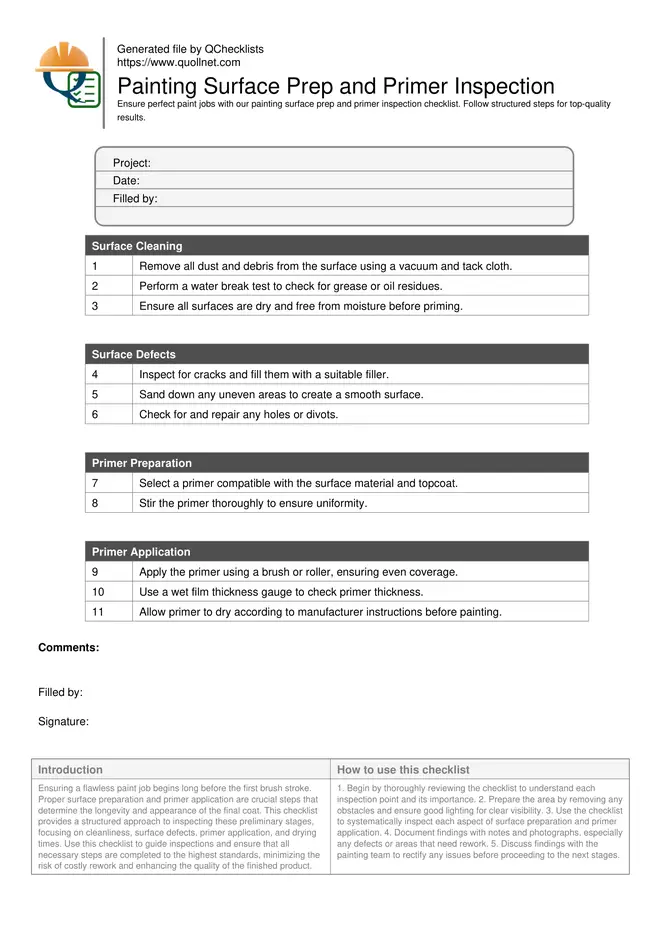Comprehensive Painting Surface Prep and Primer Inspection Checklist
Ensuring a flawless paint job begins long before the first brush stroke. Proper surface preparation and primer application are crucial steps that determine the longevity and appearance of the final coat. This checklist provides a structured approach to inspecting these preliminary stages, focusing on cleanliness, surface defects, primer application, and drying times. Use this checklist to guide inspections and ensure that all necessary steps are completed to the highest standards, minimizing the risk of costly rework and enhancing the quality of the finished product.
- Ensure surfaces are clean and free of contaminants for optimal primer adhesion.
- Identify and rectify surface defects before primer application to prevent paint failures.
- Verify primer application is uniform and meets manufacturer specifications.
- Confirm adequate drying times to ensure primer effectiveness and paint adhesion.
- Utilize this checklist to streamline inspections and maintain high-quality standards.
Surface Cleaning
Surface Defects
Primer Preparation
Primer Application
Importance of Surface Cleanliness
A clean surface is essential for good adhesion of primer and paint. Contaminants such as dust, grease, and old paint can prevent primers from bonding effectively. This can lead to peeling and other paint failures. Inspecting for cleanliness involves checking for visible debris and using tests to detect invisible contaminants.
- Check for visible dust and dirt on surfaces.
- Use a solvent wipe to test for grease or oil residues.
- Ensure old paint is removed or properly sanded down.
- Verify that all surfaces are dry before primer application.
Detecting Surface Defects
Surface defects such as cracks, holes, and uneven textures can affect the final appearance of paint. Identifying and rectifying these issues is a critical step in preparation. This involves visual inspections and, if necessary, using tools to measure surface evenness.
- Inspect for cracks and holes that need filling.
- Check surface evenness with a straight edge or level.
- Ensure any repairs are smooth and flush with surrounding areas.
- Confirm all repairs are fully dry and cured before priming.
Primer Application Standards
Applying primer correctly is crucial for good adhesion and uniform appearance of the paint. The application should be even, and the primer should be suitable for the type of surface and paint. Inspectors should ensure that primers are applied under the right conditions and meet all manufacturer guidelines.
- Verify primer type matches surface and paint requirements.
- Ensure primer is applied evenly with no streaks or patches.
- Check that application conditions (temperature, humidity) are ideal.
- Confirm primer thickness using a wet film thickness gauge.
How to Use the Painting Surface Preparation and Primer Inspection Checklist
- Begin by thoroughly reviewing the checklist to understand each inspection point and its importance.
- Prepare the area by removing any obstacles and ensure good lighting for clear visibility.
- Use the checklist to systematically inspect each aspect of surface preparation and primer application.
- Document findings with notes and photographs, especially any defects or areas that need rework.
- Discuss findings with the painting team to rectify any issues before proceeding to the next stages.
Call to Action
- Start Checklist Tick off tasks, leave comments on items or the whole form, and export your completed report to PDF or Excel—with a built-in QR code for authenticity.
- Download Excel - Painting Surface Preparation and Primer Inspection Checklist
- Download PDF - Painting Surface Preparation and Primer Inspection Checklist
- View Image - Painting Surface Preparation and Primer Inspection Checklist

